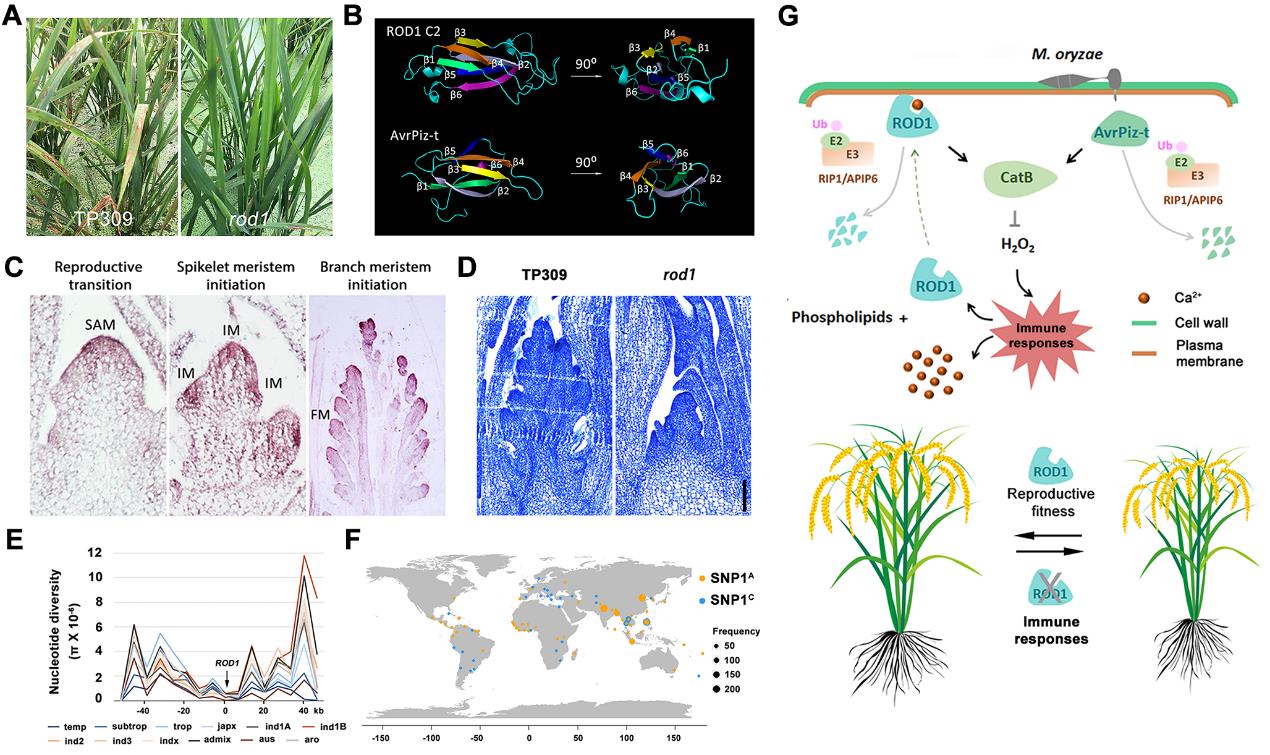Due to the sessile nature, plants are constantly challenged by diverse pathogens in their natural habitats. Activation of plant immunity confers resistance against invading pathogens, but constitutive immune responses are often costly and impede growth fitness. Therefore, plant immunity requires precise control to allow rapid responses upon pathogen infection while minimizing growth penalties under normal conditions. This is particularly important for field crops such as rice (Oryza sativa), which serves as the staple food source for more than half of the world’s population.
Rice grain yield and quality are severally affected by various diseases, and one major goal of rice breeding is broad-spectrum disease resistance without yield cost. But the molecular mechanisms coordinating rice disease resistance and growth fitness have remained largely unknown. Now, in a paper published in the journal Cell, a team led by Dr. Zuhua He at the CAS Center for Excellence in Molecular Plant Sciences (CEMPS) has made a breakthrough on this topic. They have discovered for the first time a novel Ca2+ sensor, named ROD1, that balances rice immune homeostasis and inflorescence meristem growth. The identification of ROD1 may provide a possible solution for breeding disease resistant and high yield rice cultivars in the future.
Sheath blight (R. solani) is one of the most devastating rice pathogens causing dramatic yield losses, and no high resistance germplasm has been identified so far. In an effort to isolate rice genetic resources with high sheath blight resistance, Dr. He’s group had performed large scale genetic screening of diverse rice germplasm and breeder’s collections, and characterized a spontaneous recessive variant line, resistance of rice to diseases 1 (rod1). Further analysis showed that the rod1 variant also exhibited strong resistance to rice blast and bacterial blight, two other major rice diseases, suggesting that ROD1 plays a fundamental role in controlling rice immunity.
The ROD1 gene encodes a C2 domain Ca2+ sensor that that binds to lipids in a Ca2+-dependent manner. ROD1 directly activates a catalase, CatB, to promote H2O2 degradation thus attenuating rice immunity. The protein stability of ROD1 is fine-tuned by a pair of E3 ubiquitin ligases, RIP1 and APIP6. Comparison of ROD1 coding sequences in different rice accessions revealed a resistant allele that is mainly distributed in low-latitude areas and enriched in indica rice varieties, which correlates with the wide cultivation of indica rice in tropical and subtropical regions, indicating selection of immune alleles adapted to local climate and agroecological conditions. Intriguingly, the authors found that AvrPiz-t, an effector of rice blast fungal pathogen Magnaporthe oryzae, exhibits a similar protein structure as ROD1, and shares the ROD1 protein surveillance immune suppression cascade.
This study reveals a plant host-pathogen convergent immune suppression network that ingrates Ca2+ sensing, ROS homeostasis, and immune homeostasis. The ROD1-mediated crosstalk between disease resistance and inflorescent meristem development implies a new strategy for crop engineering, and it also provides direct evidence supporting the theory of co-evolution between pathogen invading strategy and plant immune machinery.
Fig. Main findings in the article. (A) Field blast resistance of TP309 and rod1 grown in the natural nursery. (B) Structural mimicry between ROD1 and the fungal blast effector AvrPiz-t. (C) ROD1 is specifically expressed in rice inflorescence meristem. (D) ROD1 regulates inflorescence primordia development. (E) Reduced nucleotide diversity in ROD1 genomic region. (F) A natural allele enriched in the tropical and subtropical regions enhanced rice disease resistance. (G) ROD1-mediated coordination of rice disease resistance and growth fitness.
Journal Reference
Mingjun Gao, Yang He, Xin Yin, Xiangbin Zhong, Bingxiao Yan, Yue Wu, Jin Chen, Xiaoyuan Li, Keran Zhai, Yifeng Huang, Xiangyu Gong, Huizhong Chang, Shenghan Xie, Jiyun Liu, Jiaxing Yue, Jianlong Xu, Guiquan Zhang, Yiwen Deng, Ertao Wang, Didier Tharreau, Guo-Liang Wang, Weibing Yang, and Zuhua He. (2021). Ca2+ sensor-mediated ROS scavenging suppresses rice immunity and is exploited by a fungal effector. Cell via First Release on 30 September 2021.
Article Link: https://doi.org/10.1016/j.cell.2021.09.009
Contact:
Prof. Zuhua He
National Key Laboratory of Plant Molecular Genetics, Center for Excellence in Molecular Plant Sciences (CEMPS), Chinese Academic of Sciences
Tel: 86-21-54924121
Email:zhhe@cemps.ac.cn
